UWS MARK07008: Comprehensive Report on the 4 Ps of Marketing Mix
VerifiedAdded on 2023/06/09
|13
|3993
|114
Report
AI Summary
This report provides a comprehensive overview of the 4 Ps of the marketing mix: product, price, place, and promotion. The product section discusses branding, packaging, and labeling, providing examples like Unilever. The price section explores pricing objectives, cost of product, and profit margins, along with the impact of price on demand and profitability. The place section focuses on distribution channels and physical distribution, including order processing, transportation, warehousing, and inventory control. The promotion section, though not fully detailed in the provided text, completes the 4 Ps framework. The report uses examples from companies like Unilever and Tesco to illustrate the application of these marketing principles. It highlights the importance of each element in creating successful marketing strategies and achieving business objectives. This report is a valuable resource for understanding the fundamentals of marketing and its practical applications in various business contexts.
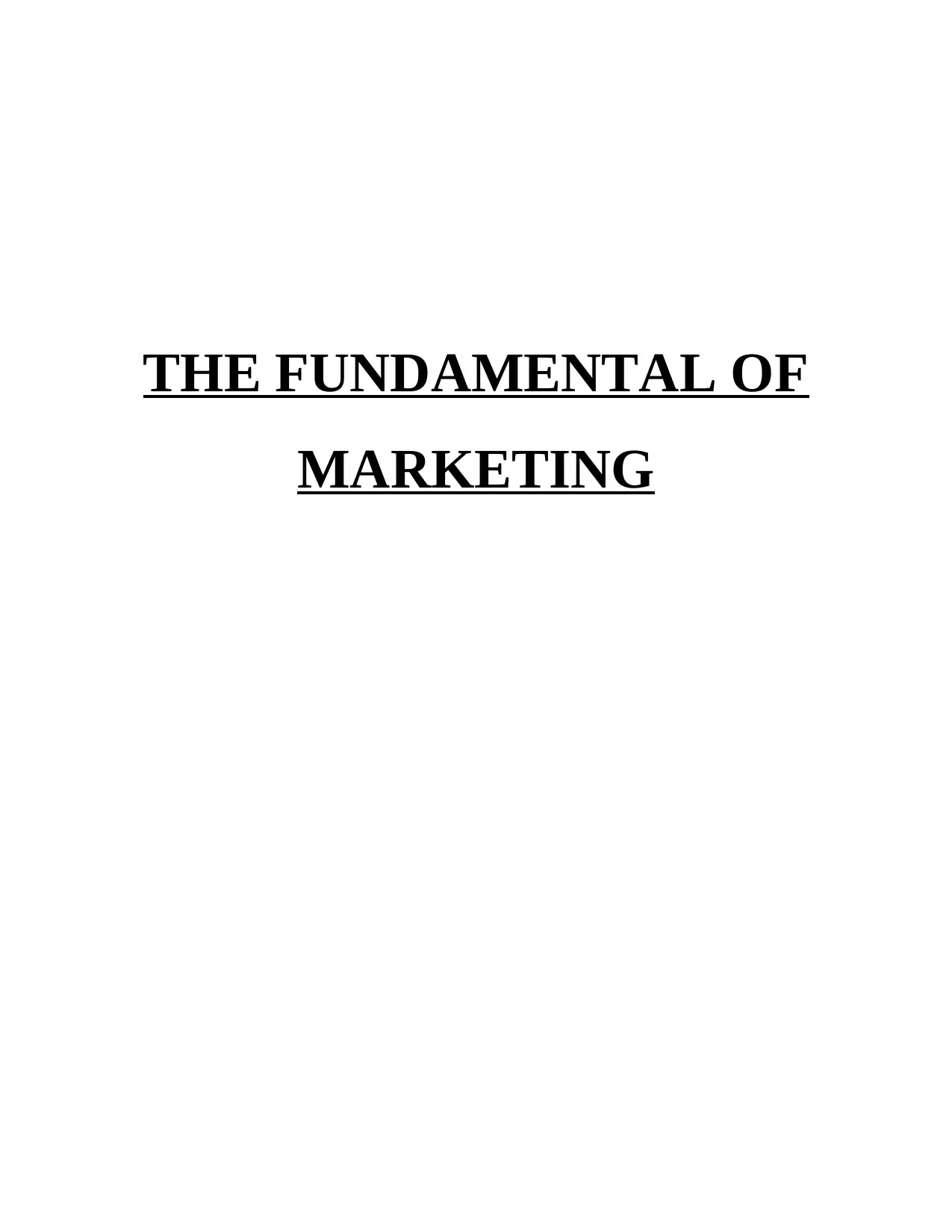
THE FUNDAMENTAL OF
MARKETING
MARKETING
Paraphrase This Document
Need a fresh take? Get an instant paraphrase of this document with our AI Paraphraser
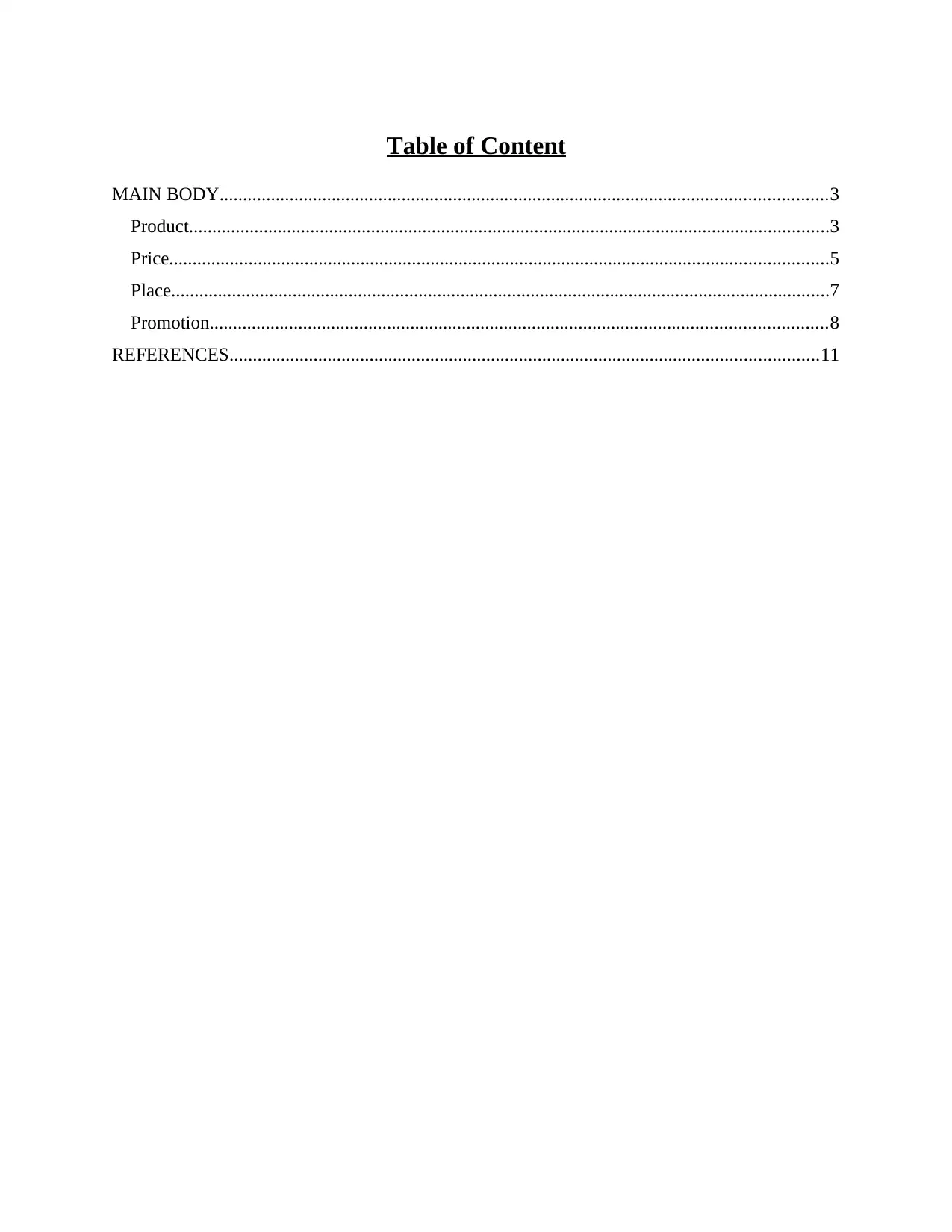
Table of Content
MAIN BODY..................................................................................................................................3
Product.........................................................................................................................................3
Price.............................................................................................................................................5
Place.............................................................................................................................................7
Promotion....................................................................................................................................8
REFERENCES..............................................................................................................................11
MAIN BODY..................................................................................................................................3
Product.........................................................................................................................................3
Price.............................................................................................................................................5
Place.............................................................................................................................................7
Promotion....................................................................................................................................8
REFERENCES..............................................................................................................................11
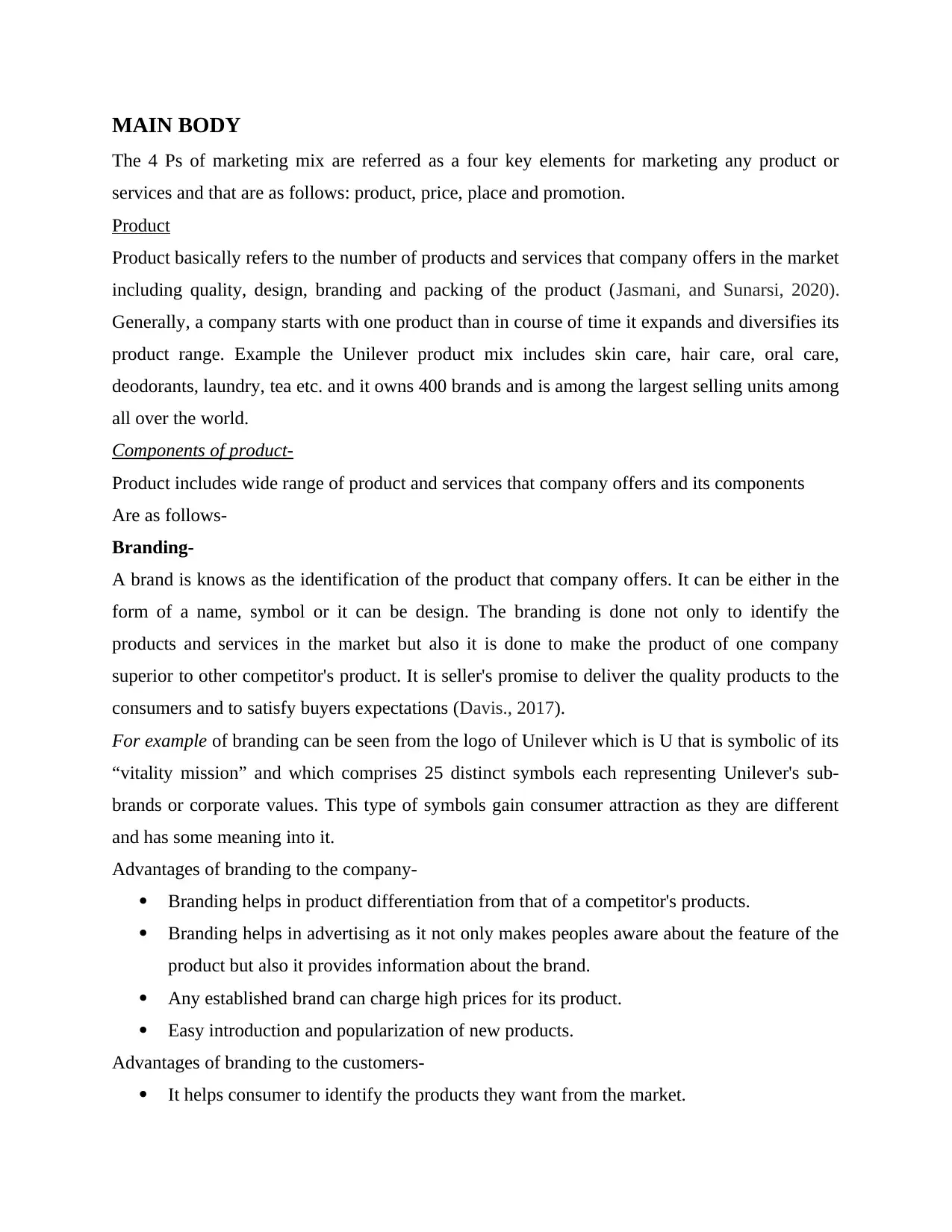
MAIN BODY
The 4 Ps of marketing mix are referred as a four key elements for marketing any product or
services and that are as follows: product, price, place and promotion.
Product
Product basically refers to the number of products and services that company offers in the market
including quality, design, branding and packing of the product (Jasmani, and Sunarsi, 2020).
Generally, a company starts with one product than in course of time it expands and diversifies its
product range. Example the Unilever product mix includes skin care, hair care, oral care,
deodorants, laundry, tea etc. and it owns 400 brands and is among the largest selling units among
all over the world.
Components of product-
Product includes wide range of product and services that company offers and its components
Are as follows-
Branding-
A brand is knows as the identification of the product that company offers. It can be either in the
form of a name, symbol or it can be design. The branding is done not only to identify the
products and services in the market but also it is done to make the product of one company
superior to other competitor's product. It is seller's promise to deliver the quality products to the
consumers and to satisfy buyers expectations (Davis., 2017).
For example of branding can be seen from the logo of Unilever which is U that is symbolic of its
“vitality mission” and which comprises 25 distinct symbols each representing Unilever's sub-
brands or corporate values. This type of symbols gain consumer attraction as they are different
and has some meaning into it.
Advantages of branding to the company-
Branding helps in product differentiation from that of a competitor's products.
Branding helps in advertising as it not only makes peoples aware about the feature of the
product but also it provides information about the brand.
Any established brand can charge high prices for its product.
Easy introduction and popularization of new products.
Advantages of branding to the customers-
It helps consumer to identify the products they want from the market.
The 4 Ps of marketing mix are referred as a four key elements for marketing any product or
services and that are as follows: product, price, place and promotion.
Product
Product basically refers to the number of products and services that company offers in the market
including quality, design, branding and packing of the product (Jasmani, and Sunarsi, 2020).
Generally, a company starts with one product than in course of time it expands and diversifies its
product range. Example the Unilever product mix includes skin care, hair care, oral care,
deodorants, laundry, tea etc. and it owns 400 brands and is among the largest selling units among
all over the world.
Components of product-
Product includes wide range of product and services that company offers and its components
Are as follows-
Branding-
A brand is knows as the identification of the product that company offers. It can be either in the
form of a name, symbol or it can be design. The branding is done not only to identify the
products and services in the market but also it is done to make the product of one company
superior to other competitor's product. It is seller's promise to deliver the quality products to the
consumers and to satisfy buyers expectations (Davis., 2017).
For example of branding can be seen from the logo of Unilever which is U that is symbolic of its
“vitality mission” and which comprises 25 distinct symbols each representing Unilever's sub-
brands or corporate values. This type of symbols gain consumer attraction as they are different
and has some meaning into it.
Advantages of branding to the company-
Branding helps in product differentiation from that of a competitor's products.
Branding helps in advertising as it not only makes peoples aware about the feature of the
product but also it provides information about the brand.
Any established brand can charge high prices for its product.
Easy introduction and popularization of new products.
Advantages of branding to the customers-
It helps consumer to identify the products they want from the market.
⊘ This is a preview!⊘
Do you want full access?
Subscribe today to unlock all pages.

Trusted by 1+ million students worldwide
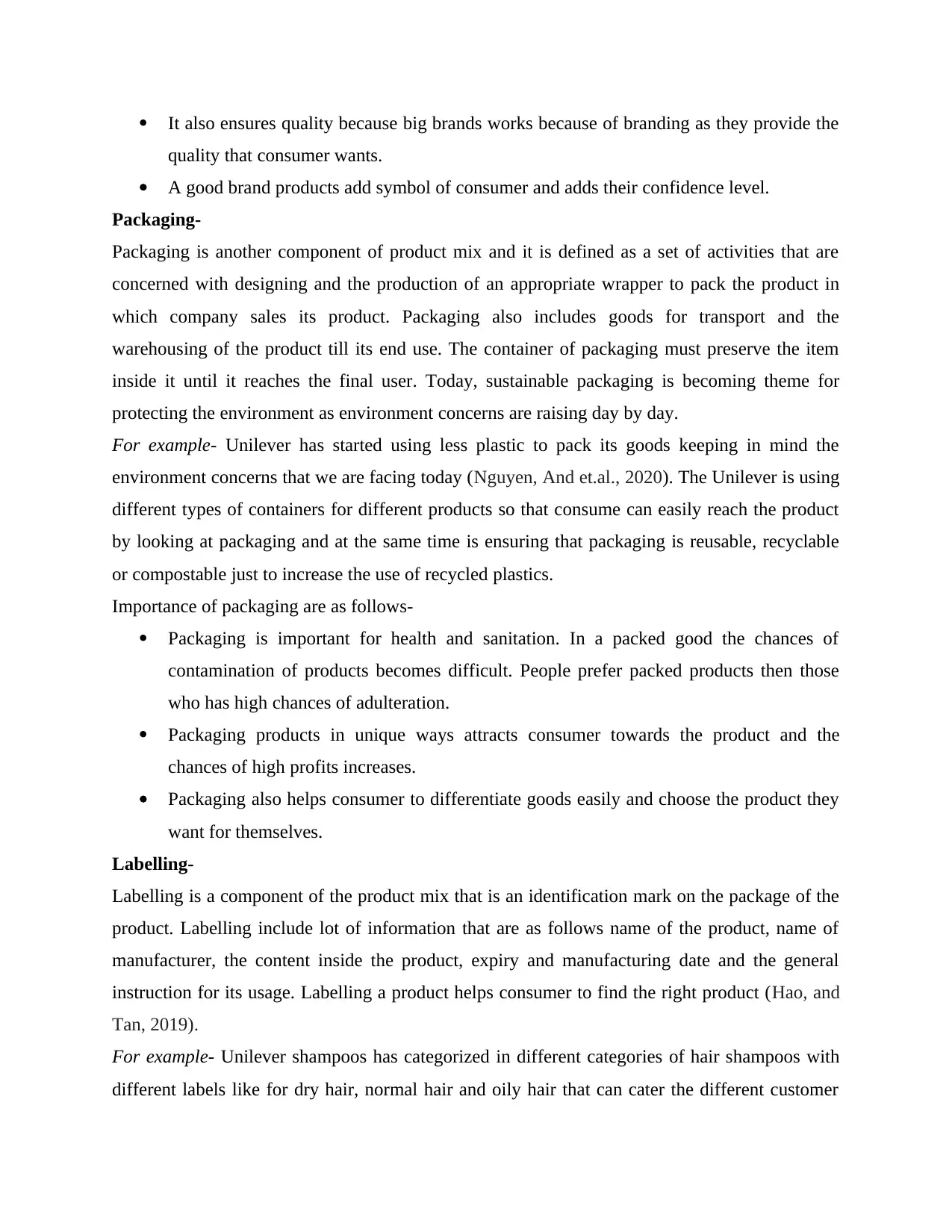
It also ensures quality because big brands works because of branding as they provide the
quality that consumer wants.
A good brand products add symbol of consumer and adds their confidence level.
Packaging-
Packaging is another component of product mix and it is defined as a set of activities that are
concerned with designing and the production of an appropriate wrapper to pack the product in
which company sales its product. Packaging also includes goods for transport and the
warehousing of the product till its end use. The container of packaging must preserve the item
inside it until it reaches the final user. Today, sustainable packaging is becoming theme for
protecting the environment as environment concerns are raising day by day.
For example- Unilever has started using less plastic to pack its goods keeping in mind the
environment concerns that we are facing today (Nguyen, And et.al., 2020). The Unilever is using
different types of containers for different products so that consume can easily reach the product
by looking at packaging and at the same time is ensuring that packaging is reusable, recyclable
or compostable just to increase the use of recycled plastics.
Importance of packaging are as follows-
Packaging is important for health and sanitation. In a packed good the chances of
contamination of products becomes difficult. People prefer packed products then those
who has high chances of adulteration.
Packaging products in unique ways attracts consumer towards the product and the
chances of high profits increases.
Packaging also helps consumer to differentiate goods easily and choose the product they
want for themselves.
Labelling-
Labelling is a component of the product mix that is an identification mark on the package of the
product. Labelling include lot of information that are as follows name of the product, name of
manufacturer, the content inside the product, expiry and manufacturing date and the general
instruction for its usage. Labelling a product helps consumer to find the right product (Hao, and
Tan, 2019).
For example- Unilever shampoos has categorized in different categories of hair shampoos with
different labels like for dry hair, normal hair and oily hair that can cater the different customer
quality that consumer wants.
A good brand products add symbol of consumer and adds their confidence level.
Packaging-
Packaging is another component of product mix and it is defined as a set of activities that are
concerned with designing and the production of an appropriate wrapper to pack the product in
which company sales its product. Packaging also includes goods for transport and the
warehousing of the product till its end use. The container of packaging must preserve the item
inside it until it reaches the final user. Today, sustainable packaging is becoming theme for
protecting the environment as environment concerns are raising day by day.
For example- Unilever has started using less plastic to pack its goods keeping in mind the
environment concerns that we are facing today (Nguyen, And et.al., 2020). The Unilever is using
different types of containers for different products so that consume can easily reach the product
by looking at packaging and at the same time is ensuring that packaging is reusable, recyclable
or compostable just to increase the use of recycled plastics.
Importance of packaging are as follows-
Packaging is important for health and sanitation. In a packed good the chances of
contamination of products becomes difficult. People prefer packed products then those
who has high chances of adulteration.
Packaging products in unique ways attracts consumer towards the product and the
chances of high profits increases.
Packaging also helps consumer to differentiate goods easily and choose the product they
want for themselves.
Labelling-
Labelling is a component of the product mix that is an identification mark on the package of the
product. Labelling include lot of information that are as follows name of the product, name of
manufacturer, the content inside the product, expiry and manufacturing date and the general
instruction for its usage. Labelling a product helps consumer to find the right product (Hao, and
Tan, 2019).
For example- Unilever shampoos has categorized in different categories of hair shampoos with
different labels like for dry hair, normal hair and oily hair that can cater the different customer
Paraphrase This Document
Need a fresh take? Get an instant paraphrase of this document with our AI Paraphraser
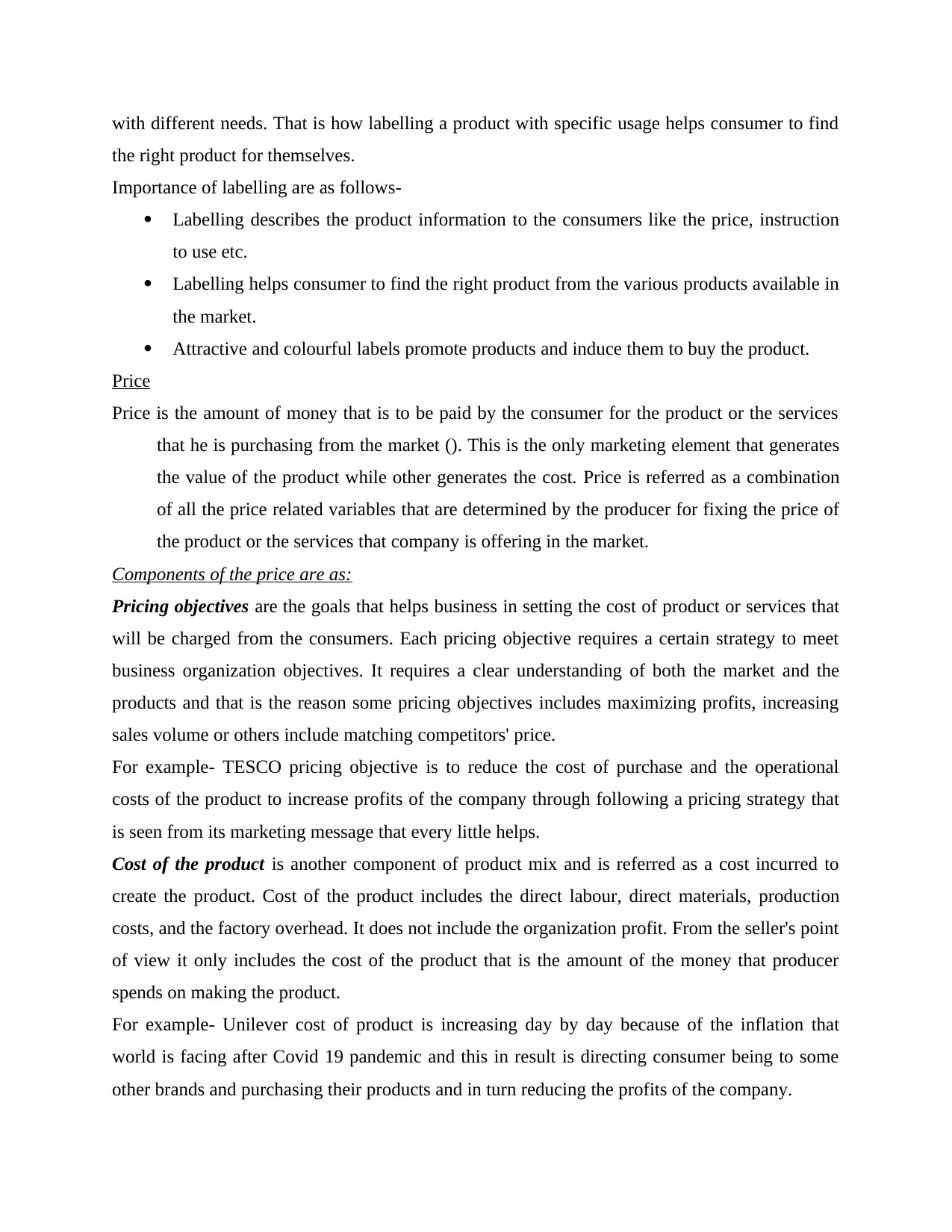
with different needs. That is how labelling a product with specific usage helps consumer to find
the right product for themselves.
Importance of labelling are as follows-
Labelling describes the product information to the consumers like the price, instruction
to use etc.
Labelling helps consumer to find the right product from the various products available in
the market.
Attractive and colourful labels promote products and induce them to buy the product.
Price
Price is the amount of money that is to be paid by the consumer for the product or the services
that he is purchasing from the market (). This is the only marketing element that generates
the value of the product while other generates the cost. Price is referred as a combination
of all the price related variables that are determined by the producer for fixing the price of
the product or the services that company is offering in the market.
Components of the price are as:
Pricing objectives are the goals that helps business in setting the cost of product or services that
will be charged from the consumers. Each pricing objective requires a certain strategy to meet
business organization objectives. It requires a clear understanding of both the market and the
products and that is the reason some pricing objectives includes maximizing profits, increasing
sales volume or others include matching competitors' price.
For example- TESCO pricing objective is to reduce the cost of purchase and the operational
costs of the product to increase profits of the company through following a pricing strategy that
is seen from its marketing message that every little helps.
Cost of the product is another component of product mix and is referred as a cost incurred to
create the product. Cost of the product includes the direct labour, direct materials, production
costs, and the factory overhead. It does not include the organization profit. From the seller's point
of view it only includes the cost of the product that is the amount of the money that producer
spends on making the product.
For example- Unilever cost of product is increasing day by day because of the inflation that
world is facing after Covid 19 pandemic and this in result is directing consumer being to some
other brands and purchasing their products and in turn reducing the profits of the company.
the right product for themselves.
Importance of labelling are as follows-
Labelling describes the product information to the consumers like the price, instruction
to use etc.
Labelling helps consumer to find the right product from the various products available in
the market.
Attractive and colourful labels promote products and induce them to buy the product.
Price
Price is the amount of money that is to be paid by the consumer for the product or the services
that he is purchasing from the market (). This is the only marketing element that generates
the value of the product while other generates the cost. Price is referred as a combination
of all the price related variables that are determined by the producer for fixing the price of
the product or the services that company is offering in the market.
Components of the price are as:
Pricing objectives are the goals that helps business in setting the cost of product or services that
will be charged from the consumers. Each pricing objective requires a certain strategy to meet
business organization objectives. It requires a clear understanding of both the market and the
products and that is the reason some pricing objectives includes maximizing profits, increasing
sales volume or others include matching competitors' price.
For example- TESCO pricing objective is to reduce the cost of purchase and the operational
costs of the product to increase profits of the company through following a pricing strategy that
is seen from its marketing message that every little helps.
Cost of the product is another component of product mix and is referred as a cost incurred to
create the product. Cost of the product includes the direct labour, direct materials, production
costs, and the factory overhead. It does not include the organization profit. From the seller's point
of view it only includes the cost of the product that is the amount of the money that producer
spends on making the product.
For example- Unilever cost of product is increasing day by day because of the inflation that
world is facing after Covid 19 pandemic and this in result is directing consumer being to some
other brands and purchasing their products and in turn reducing the profits of the company.
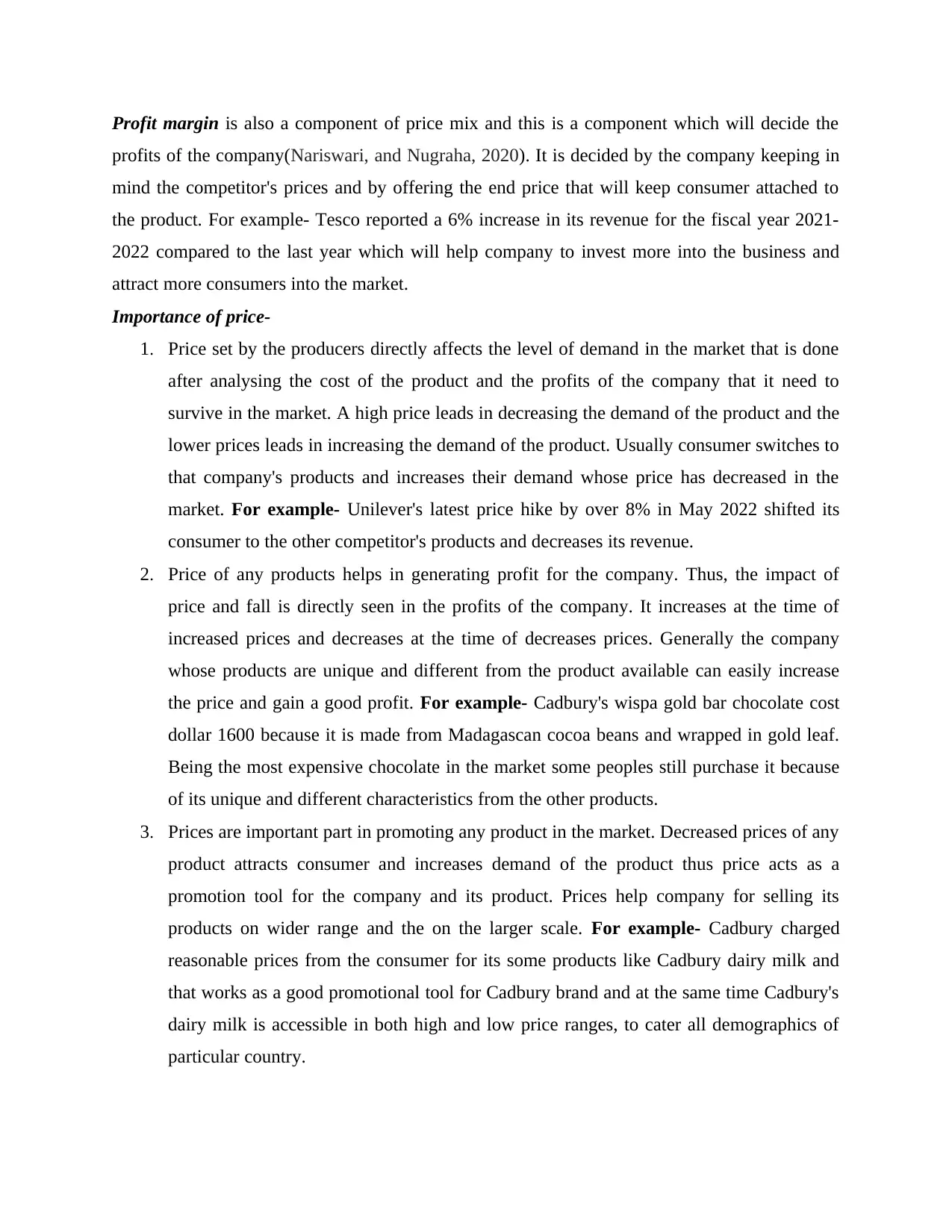
Profit margin is also a component of price mix and this is a component which will decide the
profits of the company(Nariswari, and Nugraha, 2020). It is decided by the company keeping in
mind the competitor's prices and by offering the end price that will keep consumer attached to
the product. For example- Tesco reported a 6% increase in its revenue for the fiscal year 2021-
2022 compared to the last year which will help company to invest more into the business and
attract more consumers into the market.
Importance of price-
1. Price set by the producers directly affects the level of demand in the market that is done
after analysing the cost of the product and the profits of the company that it need to
survive in the market. A high price leads in decreasing the demand of the product and the
lower prices leads in increasing the demand of the product. Usually consumer switches to
that company's products and increases their demand whose price has decreased in the
market. For example- Unilever's latest price hike by over 8% in May 2022 shifted its
consumer to the other competitor's products and decreases its revenue.
2. Price of any products helps in generating profit for the company. Thus, the impact of
price and fall is directly seen in the profits of the company. It increases at the time of
increased prices and decreases at the time of decreases prices. Generally the company
whose products are unique and different from the product available can easily increase
the price and gain a good profit. For example- Cadbury's wispa gold bar chocolate cost
dollar 1600 because it is made from Madagascan cocoa beans and wrapped in gold leaf.
Being the most expensive chocolate in the market some peoples still purchase it because
of its unique and different characteristics from the other products.
3. Prices are important part in promoting any product in the market. Decreased prices of any
product attracts consumer and increases demand of the product thus price acts as a
promotion tool for the company and its product. Prices help company for selling its
products on wider range and the on the larger scale. For example- Cadbury charged
reasonable prices from the consumer for its some products like Cadbury dairy milk and
that works as a good promotional tool for Cadbury brand and at the same time Cadbury's
dairy milk is accessible in both high and low price ranges, to cater all demographics of
particular country.
profits of the company(Nariswari, and Nugraha, 2020). It is decided by the company keeping in
mind the competitor's prices and by offering the end price that will keep consumer attached to
the product. For example- Tesco reported a 6% increase in its revenue for the fiscal year 2021-
2022 compared to the last year which will help company to invest more into the business and
attract more consumers into the market.
Importance of price-
1. Price set by the producers directly affects the level of demand in the market that is done
after analysing the cost of the product and the profits of the company that it need to
survive in the market. A high price leads in decreasing the demand of the product and the
lower prices leads in increasing the demand of the product. Usually consumer switches to
that company's products and increases their demand whose price has decreased in the
market. For example- Unilever's latest price hike by over 8% in May 2022 shifted its
consumer to the other competitor's products and decreases its revenue.
2. Price of any products helps in generating profit for the company. Thus, the impact of
price and fall is directly seen in the profits of the company. It increases at the time of
increased prices and decreases at the time of decreases prices. Generally the company
whose products are unique and different from the product available can easily increase
the price and gain a good profit. For example- Cadbury's wispa gold bar chocolate cost
dollar 1600 because it is made from Madagascan cocoa beans and wrapped in gold leaf.
Being the most expensive chocolate in the market some peoples still purchase it because
of its unique and different characteristics from the other products.
3. Prices are important part in promoting any product in the market. Decreased prices of any
product attracts consumer and increases demand of the product thus price acts as a
promotion tool for the company and its product. Prices help company for selling its
products on wider range and the on the larger scale. For example- Cadbury charged
reasonable prices from the consumer for its some products like Cadbury dairy milk and
that works as a good promotional tool for Cadbury brand and at the same time Cadbury's
dairy milk is accessible in both high and low price ranges, to cater all demographics of
particular country.
⊘ This is a preview!⊘
Do you want full access?
Subscribe today to unlock all pages.

Trusted by 1+ million students worldwide
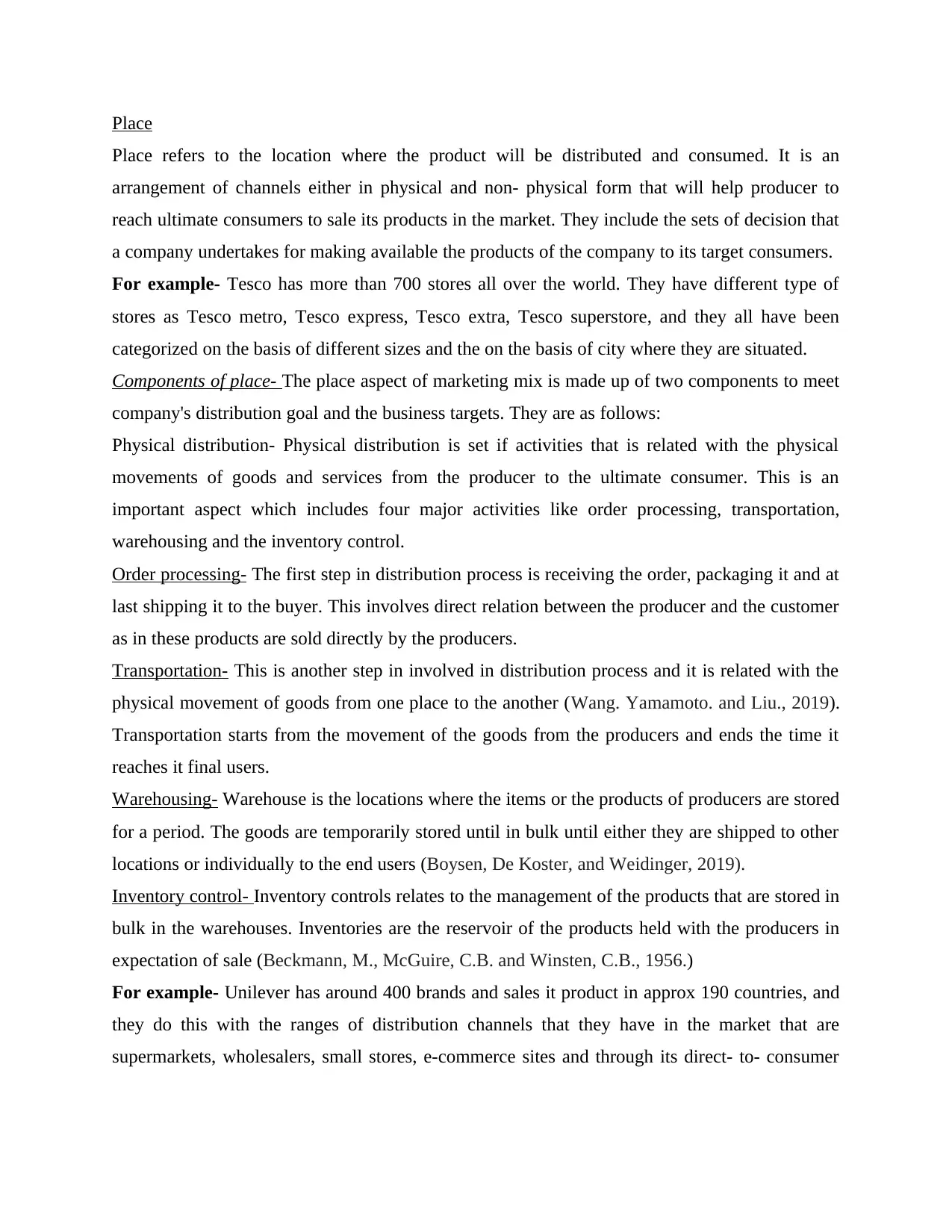
Place
Place refers to the location where the product will be distributed and consumed. It is an
arrangement of channels either in physical and non- physical form that will help producer to
reach ultimate consumers to sale its products in the market. They include the sets of decision that
a company undertakes for making available the products of the company to its target consumers.
For example- Tesco has more than 700 stores all over the world. They have different type of
stores as Tesco metro, Tesco express, Tesco extra, Tesco superstore, and they all have been
categorized on the basis of different sizes and the on the basis of city where they are situated.
Components of place- The place aspect of marketing mix is made up of two components to meet
company's distribution goal and the business targets. They are as follows:
Physical distribution- Physical distribution is set if activities that is related with the physical
movements of goods and services from the producer to the ultimate consumer. This is an
important aspect which includes four major activities like order processing, transportation,
warehousing and the inventory control.
Order processing- The first step in distribution process is receiving the order, packaging it and at
last shipping it to the buyer. This involves direct relation between the producer and the customer
as in these products are sold directly by the producers.
Transportation- This is another step in involved in distribution process and it is related with the
physical movement of goods from one place to the another (Wang. Yamamoto. and Liu., 2019).
Transportation starts from the movement of the goods from the producers and ends the time it
reaches it final users.
Warehousing- Warehouse is the locations where the items or the products of producers are stored
for a period. The goods are temporarily stored until in bulk until either they are shipped to other
locations or individually to the end users (Boysen, De Koster, and Weidinger, 2019).
Inventory control- Inventory controls relates to the management of the products that are stored in
bulk in the warehouses. Inventories are the reservoir of the products held with the producers in
expectation of sale (Beckmann, M., McGuire, C.B. and Winsten, C.B., 1956.)
For example- Unilever has around 400 brands and sales it product in approx 190 countries, and
they do this with the ranges of distribution channels that they have in the market that are
supermarkets, wholesalers, small stores, e-commerce sites and through its direct- to- consumer
Place refers to the location where the product will be distributed and consumed. It is an
arrangement of channels either in physical and non- physical form that will help producer to
reach ultimate consumers to sale its products in the market. They include the sets of decision that
a company undertakes for making available the products of the company to its target consumers.
For example- Tesco has more than 700 stores all over the world. They have different type of
stores as Tesco metro, Tesco express, Tesco extra, Tesco superstore, and they all have been
categorized on the basis of different sizes and the on the basis of city where they are situated.
Components of place- The place aspect of marketing mix is made up of two components to meet
company's distribution goal and the business targets. They are as follows:
Physical distribution- Physical distribution is set if activities that is related with the physical
movements of goods and services from the producer to the ultimate consumer. This is an
important aspect which includes four major activities like order processing, transportation,
warehousing and the inventory control.
Order processing- The first step in distribution process is receiving the order, packaging it and at
last shipping it to the buyer. This involves direct relation between the producer and the customer
as in these products are sold directly by the producers.
Transportation- This is another step in involved in distribution process and it is related with the
physical movement of goods from one place to the another (Wang. Yamamoto. and Liu., 2019).
Transportation starts from the movement of the goods from the producers and ends the time it
reaches it final users.
Warehousing- Warehouse is the locations where the items or the products of producers are stored
for a period. The goods are temporarily stored until in bulk until either they are shipped to other
locations or individually to the end users (Boysen, De Koster, and Weidinger, 2019).
Inventory control- Inventory controls relates to the management of the products that are stored in
bulk in the warehouses. Inventories are the reservoir of the products held with the producers in
expectation of sale (Beckmann, M., McGuire, C.B. and Winsten, C.B., 1956.)
For example- Unilever has around 400 brands and sales it product in approx 190 countries, and
they do this with the ranges of distribution channels that they have in the market that are
supermarkets, wholesalers, small stores, e-commerce sites and through its direct- to- consumer
Paraphrase This Document
Need a fresh take? Get an instant paraphrase of this document with our AI Paraphraser
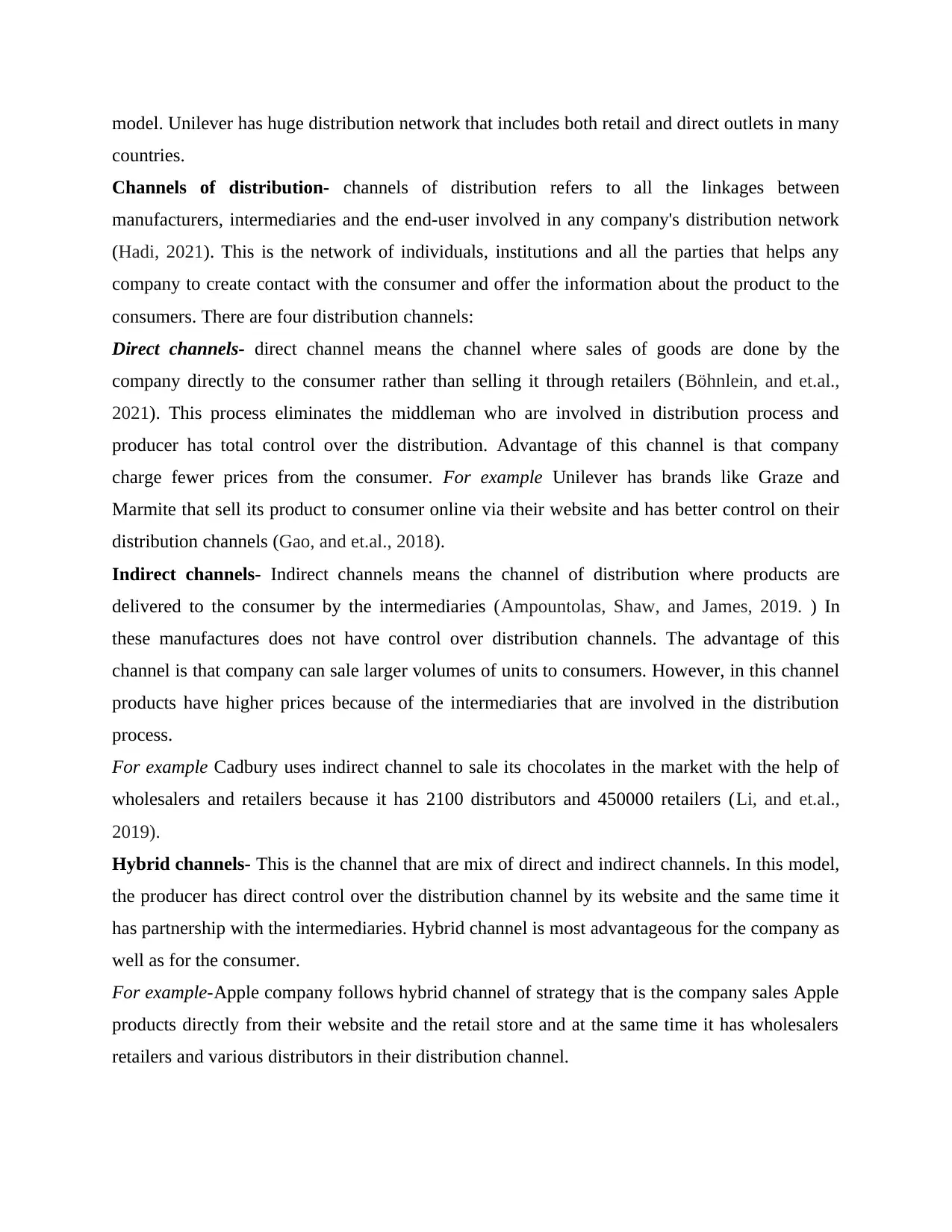
model. Unilever has huge distribution network that includes both retail and direct outlets in many
countries.
Channels of distribution- channels of distribution refers to all the linkages between
manufacturers, intermediaries and the end-user involved in any company's distribution network
(Hadi, 2021). This is the network of individuals, institutions and all the parties that helps any
company to create contact with the consumer and offer the information about the product to the
consumers. There are four distribution channels:
Direct channels- direct channel means the channel where sales of goods are done by the
company directly to the consumer rather than selling it through retailers (Böhnlein, and et.al.,
2021). This process eliminates the middleman who are involved in distribution process and
producer has total control over the distribution. Advantage of this channel is that company
charge fewer prices from the consumer. For example Unilever has brands like Graze and
Marmite that sell its product to consumer online via their website and has better control on their
distribution channels (Gao, and et.al., 2018).
Indirect channels- Indirect channels means the channel of distribution where products are
delivered to the consumer by the intermediaries (Ampountolas, Shaw, and James, 2019. ) In
these manufactures does not have control over distribution channels. The advantage of this
channel is that company can sale larger volumes of units to consumers. However, in this channel
products have higher prices because of the intermediaries that are involved in the distribution
process.
For example Cadbury uses indirect channel to sale its chocolates in the market with the help of
wholesalers and retailers because it has 2100 distributors and 450000 retailers (Li, and et.al.,
2019).
Hybrid channels- This is the channel that are mix of direct and indirect channels. In this model,
the producer has direct control over the distribution channel by its website and the same time it
has partnership with the intermediaries. Hybrid channel is most advantageous for the company as
well as for the consumer.
For example-Apple company follows hybrid channel of strategy that is the company sales Apple
products directly from their website and the retail store and at the same time it has wholesalers
retailers and various distributors in their distribution channel.
countries.
Channels of distribution- channels of distribution refers to all the linkages between
manufacturers, intermediaries and the end-user involved in any company's distribution network
(Hadi, 2021). This is the network of individuals, institutions and all the parties that helps any
company to create contact with the consumer and offer the information about the product to the
consumers. There are four distribution channels:
Direct channels- direct channel means the channel where sales of goods are done by the
company directly to the consumer rather than selling it through retailers (Böhnlein, and et.al.,
2021). This process eliminates the middleman who are involved in distribution process and
producer has total control over the distribution. Advantage of this channel is that company
charge fewer prices from the consumer. For example Unilever has brands like Graze and
Marmite that sell its product to consumer online via their website and has better control on their
distribution channels (Gao, and et.al., 2018).
Indirect channels- Indirect channels means the channel of distribution where products are
delivered to the consumer by the intermediaries (Ampountolas, Shaw, and James, 2019. ) In
these manufactures does not have control over distribution channels. The advantage of this
channel is that company can sale larger volumes of units to consumers. However, in this channel
products have higher prices because of the intermediaries that are involved in the distribution
process.
For example Cadbury uses indirect channel to sale its chocolates in the market with the help of
wholesalers and retailers because it has 2100 distributors and 450000 retailers (Li, and et.al.,
2019).
Hybrid channels- This is the channel that are mix of direct and indirect channels. In this model,
the producer has direct control over the distribution channel by its website and the same time it
has partnership with the intermediaries. Hybrid channel is most advantageous for the company as
well as for the consumer.
For example-Apple company follows hybrid channel of strategy that is the company sales Apple
products directly from their website and the retail store and at the same time it has wholesalers
retailers and various distributors in their distribution channel.
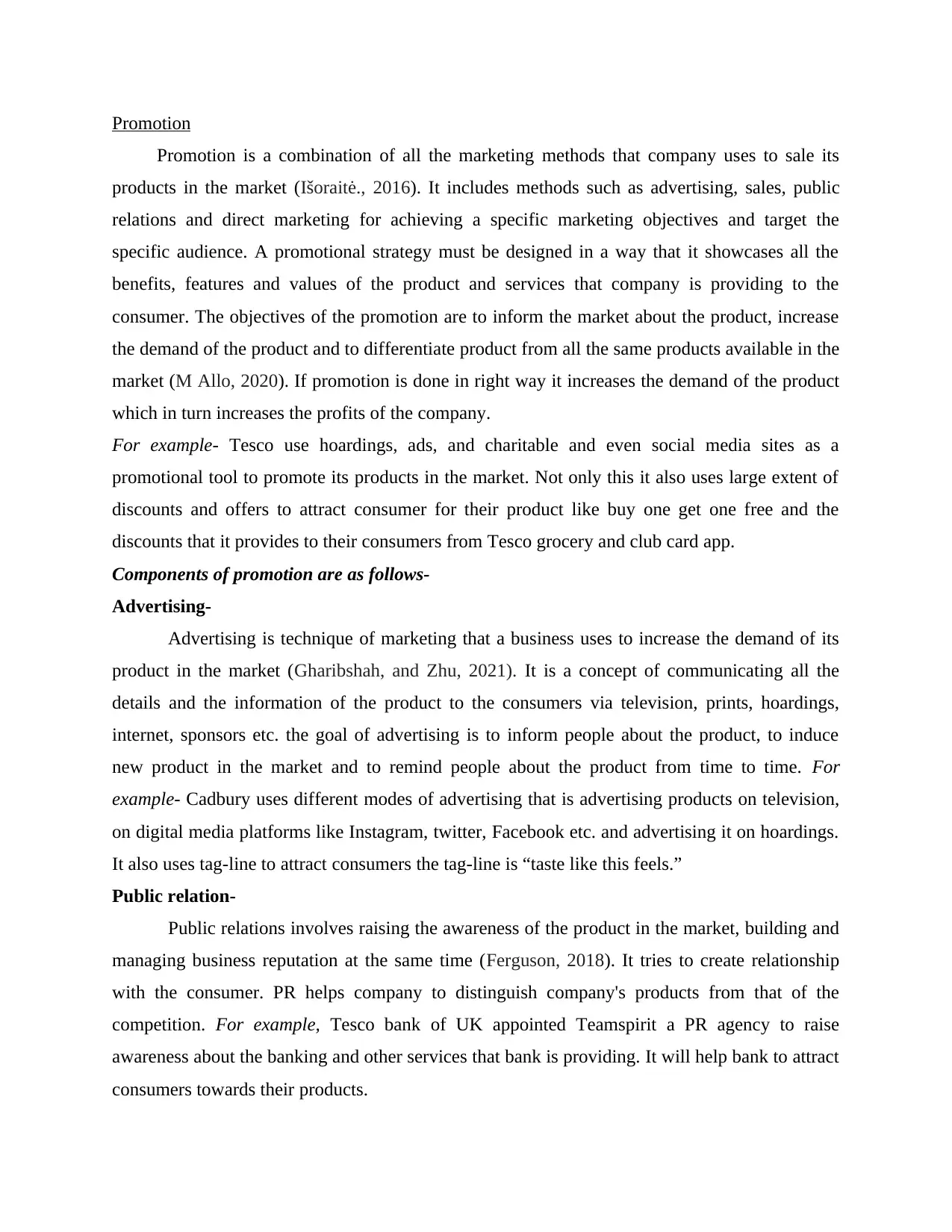
Promotion
Promotion is a combination of all the marketing methods that company uses to sale its
products in the market (Išoraitė., 2016). It includes methods such as advertising, sales, public
relations and direct marketing for achieving a specific marketing objectives and target the
specific audience. A promotional strategy must be designed in a way that it showcases all the
benefits, features and values of the product and services that company is providing to the
consumer. The objectives of the promotion are to inform the market about the product, increase
the demand of the product and to differentiate product from all the same products available in the
market (M Allo, 2020). If promotion is done in right way it increases the demand of the product
which in turn increases the profits of the company.
For example- Tesco use hoardings, ads, and charitable and even social media sites as a
promotional tool to promote its products in the market. Not only this it also uses large extent of
discounts and offers to attract consumer for their product like buy one get one free and the
discounts that it provides to their consumers from Tesco grocery and club card app.
Components of promotion are as follows-
Advertising-
Advertising is technique of marketing that a business uses to increase the demand of its
product in the market (Gharibshah, and Zhu, 2021). It is a concept of communicating all the
details and the information of the product to the consumers via television, prints, hoardings,
internet, sponsors etc. the goal of advertising is to inform people about the product, to induce
new product in the market and to remind people about the product from time to time. For
example- Cadbury uses different modes of advertising that is advertising products on television,
on digital media platforms like Instagram, twitter, Facebook etc. and advertising it on hoardings.
It also uses tag-line to attract consumers the tag-line is “taste like this feels.”
Public relation-
Public relations involves raising the awareness of the product in the market, building and
managing business reputation at the same time (Ferguson, 2018). It tries to create relationship
with the consumer. PR helps company to distinguish company's products from that of the
competition. For example, Tesco bank of UK appointed Teamspirit a PR agency to raise
awareness about the banking and other services that bank is providing. It will help bank to attract
consumers towards their products.
Promotion is a combination of all the marketing methods that company uses to sale its
products in the market (Išoraitė., 2016). It includes methods such as advertising, sales, public
relations and direct marketing for achieving a specific marketing objectives and target the
specific audience. A promotional strategy must be designed in a way that it showcases all the
benefits, features and values of the product and services that company is providing to the
consumer. The objectives of the promotion are to inform the market about the product, increase
the demand of the product and to differentiate product from all the same products available in the
market (M Allo, 2020). If promotion is done in right way it increases the demand of the product
which in turn increases the profits of the company.
For example- Tesco use hoardings, ads, and charitable and even social media sites as a
promotional tool to promote its products in the market. Not only this it also uses large extent of
discounts and offers to attract consumer for their product like buy one get one free and the
discounts that it provides to their consumers from Tesco grocery and club card app.
Components of promotion are as follows-
Advertising-
Advertising is technique of marketing that a business uses to increase the demand of its
product in the market (Gharibshah, and Zhu, 2021). It is a concept of communicating all the
details and the information of the product to the consumers via television, prints, hoardings,
internet, sponsors etc. the goal of advertising is to inform people about the product, to induce
new product in the market and to remind people about the product from time to time. For
example- Cadbury uses different modes of advertising that is advertising products on television,
on digital media platforms like Instagram, twitter, Facebook etc. and advertising it on hoardings.
It also uses tag-line to attract consumers the tag-line is “taste like this feels.”
Public relation-
Public relations involves raising the awareness of the product in the market, building and
managing business reputation at the same time (Ferguson, 2018). It tries to create relationship
with the consumer. PR helps company to distinguish company's products from that of the
competition. For example, Tesco bank of UK appointed Teamspirit a PR agency to raise
awareness about the banking and other services that bank is providing. It will help bank to attract
consumers towards their products.
⊘ This is a preview!⊘
Do you want full access?
Subscribe today to unlock all pages.

Trusted by 1+ million students worldwide
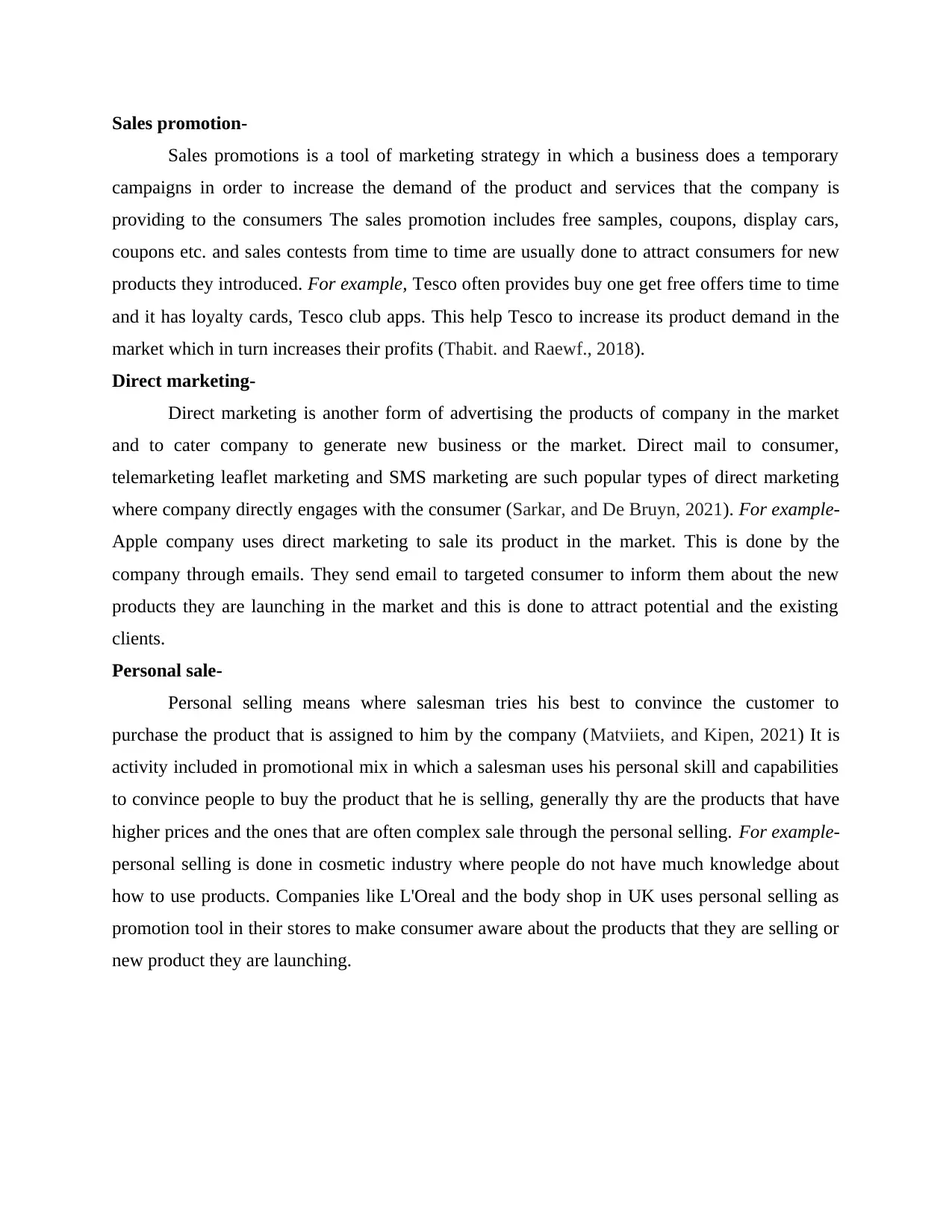
Sales promotion-
Sales promotions is a tool of marketing strategy in which a business does a temporary
campaigns in order to increase the demand of the product and services that the company is
providing to the consumers The sales promotion includes free samples, coupons, display cars,
coupons etc. and sales contests from time to time are usually done to attract consumers for new
products they introduced. For example, Tesco often provides buy one get free offers time to time
and it has loyalty cards, Tesco club apps. This help Tesco to increase its product demand in the
market which in turn increases their profits (Thabit. and Raewf., 2018).
Direct marketing-
Direct marketing is another form of advertising the products of company in the market
and to cater company to generate new business or the market. Direct mail to consumer,
telemarketing leaflet marketing and SMS marketing are such popular types of direct marketing
where company directly engages with the consumer (Sarkar, and De Bruyn, 2021). For example-
Apple company uses direct marketing to sale its product in the market. This is done by the
company through emails. They send email to targeted consumer to inform them about the new
products they are launching in the market and this is done to attract potential and the existing
clients.
Personal sale-
Personal selling means where salesman tries his best to convince the customer to
purchase the product that is assigned to him by the company (Matviiets, and Kipen, 2021) It is
activity included in promotional mix in which a salesman uses his personal skill and capabilities
to convince people to buy the product that he is selling, generally thy are the products that have
higher prices and the ones that are often complex sale through the personal selling. For example-
personal selling is done in cosmetic industry where people do not have much knowledge about
how to use products. Companies like L'Oreal and the body shop in UK uses personal selling as
promotion tool in their stores to make consumer aware about the products that they are selling or
new product they are launching.
Sales promotions is a tool of marketing strategy in which a business does a temporary
campaigns in order to increase the demand of the product and services that the company is
providing to the consumers The sales promotion includes free samples, coupons, display cars,
coupons etc. and sales contests from time to time are usually done to attract consumers for new
products they introduced. For example, Tesco often provides buy one get free offers time to time
and it has loyalty cards, Tesco club apps. This help Tesco to increase its product demand in the
market which in turn increases their profits (Thabit. and Raewf., 2018).
Direct marketing-
Direct marketing is another form of advertising the products of company in the market
and to cater company to generate new business or the market. Direct mail to consumer,
telemarketing leaflet marketing and SMS marketing are such popular types of direct marketing
where company directly engages with the consumer (Sarkar, and De Bruyn, 2021). For example-
Apple company uses direct marketing to sale its product in the market. This is done by the
company through emails. They send email to targeted consumer to inform them about the new
products they are launching in the market and this is done to attract potential and the existing
clients.
Personal sale-
Personal selling means where salesman tries his best to convince the customer to
purchase the product that is assigned to him by the company (Matviiets, and Kipen, 2021) It is
activity included in promotional mix in which a salesman uses his personal skill and capabilities
to convince people to buy the product that he is selling, generally thy are the products that have
higher prices and the ones that are often complex sale through the personal selling. For example-
personal selling is done in cosmetic industry where people do not have much knowledge about
how to use products. Companies like L'Oreal and the body shop in UK uses personal selling as
promotion tool in their stores to make consumer aware about the products that they are selling or
new product they are launching.
Paraphrase This Document
Need a fresh take? Get an instant paraphrase of this document with our AI Paraphraser
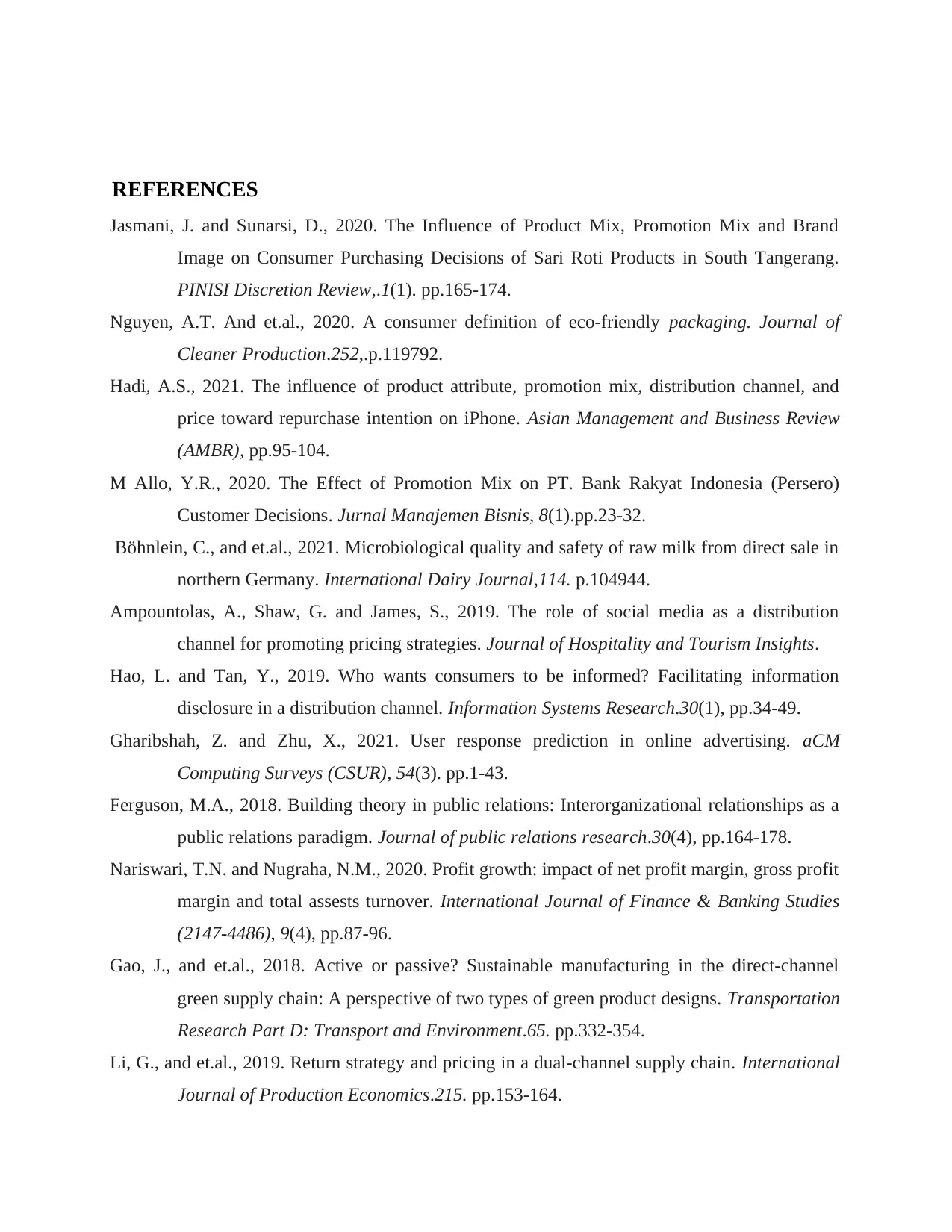
REFERENCES
Jasmani, J. and Sunarsi, D., 2020. The Influence of Product Mix, Promotion Mix and Brand
Image on Consumer Purchasing Decisions of Sari Roti Products in South Tangerang.
PINISI Discretion Review,.1(1). pp.165-174.
Nguyen, A.T. And et.al., 2020. A consumer definition of eco-friendly packaging. Journal of
Cleaner Production.252,.p.119792.
Hadi, A.S., 2021. The influence of product attribute, promotion mix, distribution channel, and
price toward repurchase intention on iPhone. Asian Management and Business Review
(AMBR), pp.95-104.
M Allo, Y.R., 2020. The Effect of Promotion Mix on PT. Bank Rakyat Indonesia (Persero)
Customer Decisions. Jurnal Manajemen Bisnis, 8(1).pp.23-32.
Böhnlein, C., and et.al., 2021. Microbiological quality and safety of raw milk from direct sale in
northern Germany. International Dairy Journal,114. p.104944.
Ampountolas, A., Shaw, G. and James, S., 2019. The role of social media as a distribution
channel for promoting pricing strategies. Journal of Hospitality and Tourism Insights.
Hao, L. and Tan, Y., 2019. Who wants consumers to be informed? Facilitating information
disclosure in a distribution channel. Information Systems Research.30(1), pp.34-49.
Gharibshah, Z. and Zhu, X., 2021. User response prediction in online advertising. aCM
Computing Surveys (CSUR), 54(3). pp.1-43.
Ferguson, M.A., 2018. Building theory in public relations: Interorganizational relationships as a
public relations paradigm. Journal of public relations research.30(4), pp.164-178.
Nariswari, T.N. and Nugraha, N.M., 2020. Profit growth: impact of net profit margin, gross profit
margin and total assests turnover. International Journal of Finance & Banking Studies
(2147-4486), 9(4), pp.87-96.
Gao, J., and et.al., 2018. Active or passive? Sustainable manufacturing in the direct-channel
green supply chain: A perspective of two types of green product designs. Transportation
Research Part D: Transport and Environment.65. pp.332-354.
Li, G., and et.al., 2019. Return strategy and pricing in a dual-channel supply chain. International
Journal of Production Economics.215. pp.153-164.
Jasmani, J. and Sunarsi, D., 2020. The Influence of Product Mix, Promotion Mix and Brand
Image on Consumer Purchasing Decisions of Sari Roti Products in South Tangerang.
PINISI Discretion Review,.1(1). pp.165-174.
Nguyen, A.T. And et.al., 2020. A consumer definition of eco-friendly packaging. Journal of
Cleaner Production.252,.p.119792.
Hadi, A.S., 2021. The influence of product attribute, promotion mix, distribution channel, and
price toward repurchase intention on iPhone. Asian Management and Business Review
(AMBR), pp.95-104.
M Allo, Y.R., 2020. The Effect of Promotion Mix on PT. Bank Rakyat Indonesia (Persero)
Customer Decisions. Jurnal Manajemen Bisnis, 8(1).pp.23-32.
Böhnlein, C., and et.al., 2021. Microbiological quality and safety of raw milk from direct sale in
northern Germany. International Dairy Journal,114. p.104944.
Ampountolas, A., Shaw, G. and James, S., 2019. The role of social media as a distribution
channel for promoting pricing strategies. Journal of Hospitality and Tourism Insights.
Hao, L. and Tan, Y., 2019. Who wants consumers to be informed? Facilitating information
disclosure in a distribution channel. Information Systems Research.30(1), pp.34-49.
Gharibshah, Z. and Zhu, X., 2021. User response prediction in online advertising. aCM
Computing Surveys (CSUR), 54(3). pp.1-43.
Ferguson, M.A., 2018. Building theory in public relations: Interorganizational relationships as a
public relations paradigm. Journal of public relations research.30(4), pp.164-178.
Nariswari, T.N. and Nugraha, N.M., 2020. Profit growth: impact of net profit margin, gross profit
margin and total assests turnover. International Journal of Finance & Banking Studies
(2147-4486), 9(4), pp.87-96.
Gao, J., and et.al., 2018. Active or passive? Sustainable manufacturing in the direct-channel
green supply chain: A perspective of two types of green product designs. Transportation
Research Part D: Transport and Environment.65. pp.332-354.
Li, G., and et.al., 2019. Return strategy and pricing in a dual-channel supply chain. International
Journal of Production Economics.215. pp.153-164.
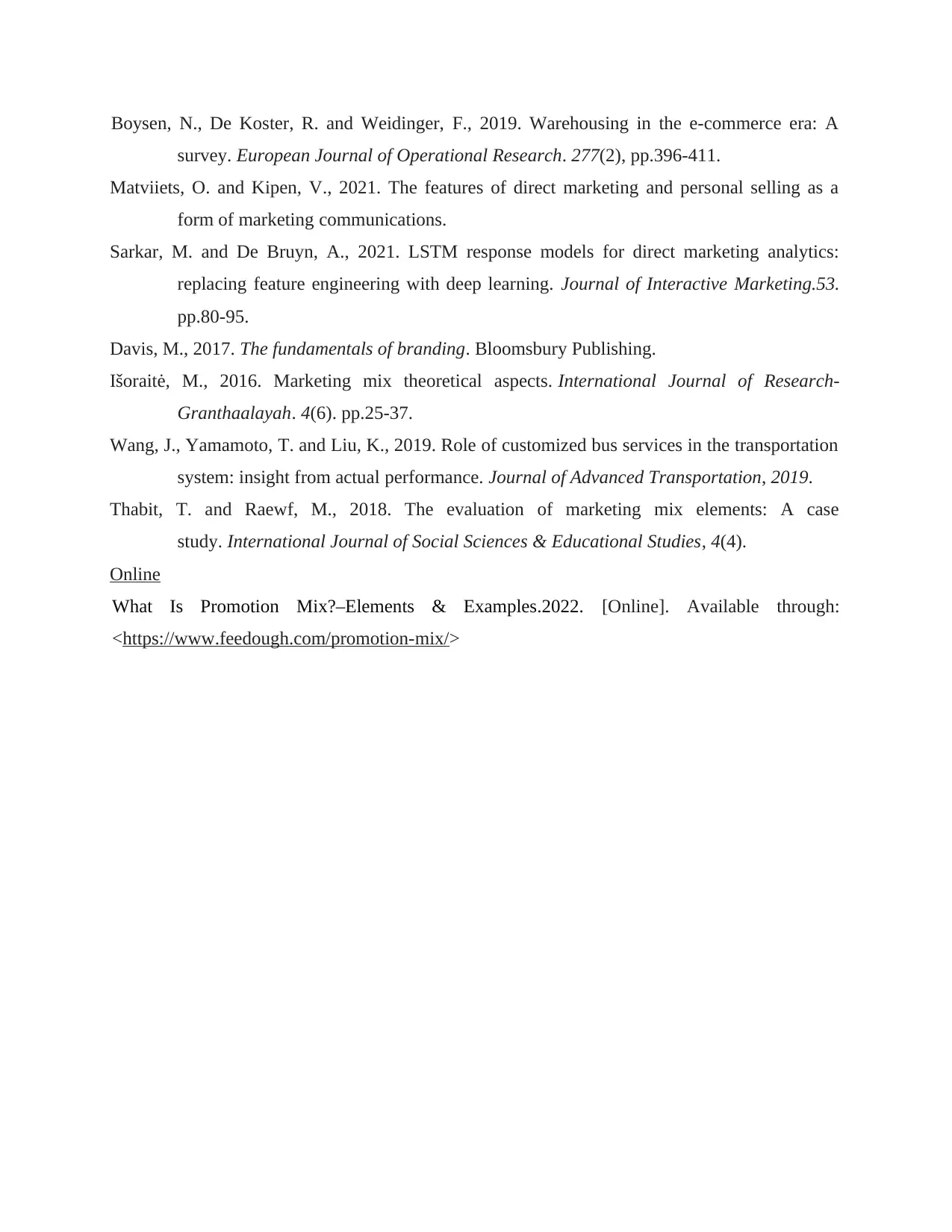
Boysen, N., De Koster, R. and Weidinger, F., 2019. Warehousing in the e-commerce era: A
survey. European Journal of Operational Research. 277(2), pp.396-411.
Matviiets, O. and Kipen, V., 2021. The features of direct marketing and personal selling as a
form of marketing communications.
Sarkar, M. and De Bruyn, A., 2021. LSTM response models for direct marketing analytics:
replacing feature engineering with deep learning. Journal of Interactive Marketing.53.
pp.80-95.
Davis, M., 2017. The fundamentals of branding. Bloomsbury Publishing.
Išoraitė, M., 2016. Marketing mix theoretical aspects. International Journal of Research-
Granthaalayah. 4(6). pp.25-37.
Wang, J., Yamamoto, T. and Liu, K., 2019. Role of customized bus services in the transportation
system: insight from actual performance. Journal of Advanced Transportation, 2019.
Thabit, T. and Raewf, M., 2018. The evaluation of marketing mix elements: A case
study. International Journal of Social Sciences & Educational Studies, 4(4).
Online
What Is Promotion Mix?–Elements & Examples.2022. [Online]. Available through:
<https://www.feedough.com/promotion-mix/>
survey. European Journal of Operational Research. 277(2), pp.396-411.
Matviiets, O. and Kipen, V., 2021. The features of direct marketing and personal selling as a
form of marketing communications.
Sarkar, M. and De Bruyn, A., 2021. LSTM response models for direct marketing analytics:
replacing feature engineering with deep learning. Journal of Interactive Marketing.53.
pp.80-95.
Davis, M., 2017. The fundamentals of branding. Bloomsbury Publishing.
Išoraitė, M., 2016. Marketing mix theoretical aspects. International Journal of Research-
Granthaalayah. 4(6). pp.25-37.
Wang, J., Yamamoto, T. and Liu, K., 2019. Role of customized bus services in the transportation
system: insight from actual performance. Journal of Advanced Transportation, 2019.
Thabit, T. and Raewf, M., 2018. The evaluation of marketing mix elements: A case
study. International Journal of Social Sciences & Educational Studies, 4(4).
Online
What Is Promotion Mix?–Elements & Examples.2022. [Online]. Available through:
<https://www.feedough.com/promotion-mix/>
⊘ This is a preview!⊘
Do you want full access?
Subscribe today to unlock all pages.

Trusted by 1+ million students worldwide
1 out of 13
Related Documents
Your All-in-One AI-Powered Toolkit for Academic Success.
+13062052269
info@desklib.com
Available 24*7 on WhatsApp / Email
![[object Object]](/_next/static/media/star-bottom.7253800d.svg)
Unlock your academic potential
Copyright © 2020–2025 A2Z Services. All Rights Reserved. Developed and managed by ZUCOL.





